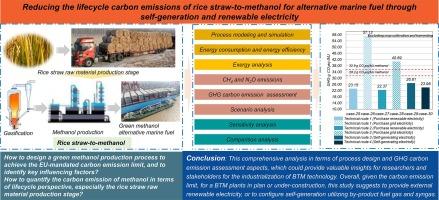Reducing the lifecycle carbon emissions of rice straw-to-methanol for alternative marine fuel through self-generation and renewable electricity
IF 9.9
1区 工程技术
Q1 ENERGY & FUELS
引用次数: 0
Abstract
The advancement of maritime decarbonization has accelerated the adoption of alternative marine fuels, particularly methanol. However, its widespread adoption encounters three primary obstacles: pricing, availability, and carbon accounting. Given the current state of technological and industrial developments, designing technical routes that comply with carbon emission restrictions is a primary concern for all project stakeholders. Therefore, based on a 100,000 tons/year biomass-to-methanol (BTM) plant located in the eastern coast of China, four integrated routes were designed and simulated to obtain steam, electricity and water balances. Energy and exergy analysis were then performed. Finally, a carbon emission assessment (calculated as equivalent carbon dioxide ‘CO2eq’) was conducted with 30 scenarios. Results indicated that the carbon emissions during rice straw production stage, including carbon emissions from methane and nitrous oxide emissions from rice fields, were 0.2020 and 0.5563 kg CO2eq/kg straw-dry using value and energy allocations, respectively. Excluding rice cultivation and harvesting, compared to the 2021 baseline level of 94 gCO2eq/MJ set by the European Union’s Renewable Energy Directive III (EU RED III), the carbon emission intensity of methanol decreased by 75.4 %, 76.2 %, 71.5 % and 74.5 %, respectively for route 1 to 4, satisfying the EU-mandated carbon emission limit. Sensitivity analysis showed that reducing rice straw consumption and energy consumption of rice straw pulverizing, drying, and shaping could effectively reduce carbon emissions. Overall, given the carbon emission limit, for a BTM plants in plan or under-construction, this study suggests to provide external renewable electricity, or to configure self-generation utilizing by-product fuel gas and syngas.

通过自发电和可再生电力减少用于替代船用燃料的稻草制甲醇的生命周期碳排放量
海洋去碳化进程的推进加快了替代船用燃料的采用,尤其是甲醇。然而,甲醇的广泛应用遇到了三个主要障碍:价格、可用性和碳核算。鉴于目前的技术和工业发展状况,设计符合碳排放限制的技术路线是所有项目利益相关者的首要关注点。因此,以位于中国东部沿海的一家年产 10 万吨生物质转化甲醇(BTM)工厂为基础,设计并模拟了四条综合路线,以获得蒸汽、电力和水的平衡。然后进行能量和放能分析。最后,对 30 种情景进行了碳排放评估(以二氧化碳当量 "CO2eq "计算)。结果表明,稻草生产阶段的碳排放量(包括稻田甲烷和氧化亚氮的碳排放量)分别为 0.2020 千克二氧化碳当量/千克稻草(干稻草)和 0.5563 千克二氧化碳当量/千克稻草(干稻草)。与欧盟可再生能源指令 III(EU RED III)规定的 2021 年 94 gCO2eq/MJ 基准水平相比,剔除水稻种植和收割,路线 1 至路线 4 的甲醇碳排放强度分别降低了 75.4%、76.2%、71.5% 和 74.5%,满足了欧盟规定的碳排放限制。敏感性分析表明,减少稻草用量以及稻草粉碎、干燥和成型的能耗可有效减少碳排放。总之,考虑到碳排放限制,本研究建议规划中或在建的 BTM 工厂提供外部可再生能源电力,或利用副产品燃料气和合成气进行自发电。
本文章由计算机程序翻译,如有差异,请以英文原文为准。
求助全文
约1分钟内获得全文
求助全文
来源期刊

Energy Conversion and Management
工程技术-力学
CiteScore
19.00
自引率
11.50%
发文量
1304
审稿时长
17 days
期刊介绍:
The journal Energy Conversion and Management provides a forum for publishing original contributions and comprehensive technical review articles of interdisciplinary and original research on all important energy topics.
The topics considered include energy generation, utilization, conversion, storage, transmission, conservation, management and sustainability. These topics typically involve various types of energy such as mechanical, thermal, nuclear, chemical, electromagnetic, magnetic and electric. These energy types cover all known energy resources, including renewable resources (e.g., solar, bio, hydro, wind, geothermal and ocean energy), fossil fuels and nuclear resources.
 求助内容:
求助内容: 应助结果提醒方式:
应助结果提醒方式:


